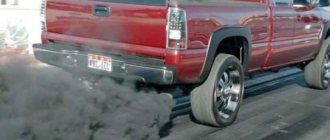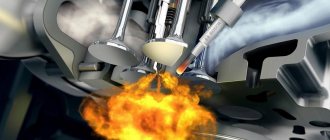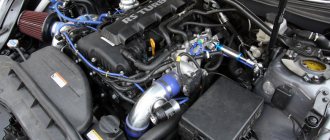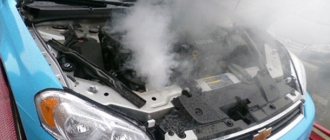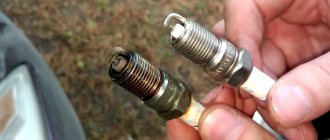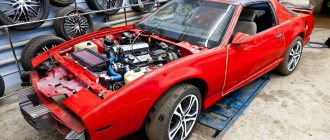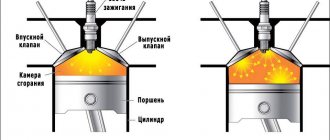Every car owner may experience one very interesting, incomprehensible headache in the form of smoke from the exhaust pipe, and especially owners of cars with a diesel unit. It seems that the car will drive and work, but the fact that it smokes will not leave its owner any peace.
The situation is interesting because the smoke can be of different colors: black, white, gray or smoke blue smoke, blue smoke is the most common. And for a certain reason, there will be smoke of a certain color.
The cause of black smoke may be fuel that has not burned completely. Smoke of this color occurs when there is an excessive supply of fuel or the fuel is of poor quality. A lack of oxygen will have the same effect. The same reasons are involved in the appearance of gray smoke. The smoke is gray in color only because the defects are not as serious as those that cause a black trail behind the car.
A diesel engine emits bluish smoke and there may be different reasons for this. If blue smoke is emitted while the car is running on a cold engine or an already warm one, then you should think about problems in the diesel unit. This effect can be caused by two problems:
- The fuel does not burn out.
- Engine oil enters the engine.
To understand why a diesel engine smokes, you need to diagnose it without resorting to the help of special devices. You can identify the problem by the degree of smokiness and the smell it carries.
Kamaz smokes white smoke - Causes and consequences
The products of the Kama Automobile Plant, located in Naberezhnye Chelny, entered everyday life, became popular and distributed in forty countries.
Mass popularity is the reason that the incorrect behavior of technology arouses consumer interest. During operation of the power plant, a frequent occurrence is the abundant release of exhaust gases and the KamAZ smokes. For a working engine, this behavior is typical when starting, but it goes away after a short period of time. If not, the symptom indicates problems in the condition of the unit. The sooner the reason why the KamAZ smokes is identified and eliminated, the longer the engine will last.
What does the KamAZ exhaust indicate?
Car exhaust, an indicator of the condition of the power plant. As already mentioned, the KamAZ diesel engine does not smoke under normal conditions. Otherwise, analysis of emissions (smoke color) will answer the question about the condition of the motor. The indicator will indicate the exact cause of the breakdown, the degree of wear and condition of the components. Damage to injectors and fuel pressure pump.
Exhaust is the remains of unburned fuel coming out in the form of gas. Visually, the emission products are visible at sub-zero temperatures, then the smog is presented in the form of steam.
When KamAZ operates, there is exhaust of the following colors:
- White issue, with an admixture of black and gray tones;
- Blue edition, with an admixture of gray tone;
- Black exhaust, with soot emissions.
White smoke pours out and won't start
White smoke pours out and won't start
Message: No. 1 vadik63 » May 01, 2016, 00:02
Re: White smoke coming out and won't start
Message: No. 2 klim67 » 01 May 2016, 01:27
Nozzle, turbine. Tell us in more detail - it will be “closer to the body,” as De Maupasant said. rates - 85% for the nozzle (it pours, does not close figuratively) the remaining 15% for the turbine. but if it becomes more and more difficult to start, there is more pressure on the injector (loses pressure in the ramp). By the way, the difficulty of diagnostics will be as follows - usually the injector fails and discharges into the return line, which is visually checked by “flasks”. When there is a malfunction in the nozzle assembly, it pours into the cylinder, and this can only be seen if you “find the car in the smoke”
Re: White smoke coming out and won't start
Message: No. 3 Anatoly » May 01, 2022, 07:17
Re: White smoke coming out and won't start
Message: No. 4 vadik63 » 01 May 2016, 07:47
Re: White smoke coming out and won't start
Message: No. 5 chur » May 01, 2016, 09:20
Re: White smoke coming out and won't start
Message: No. 6 sergeykarev57 » May 01, 2022, 09:35
Re: White smoke coming out and won't start
Message: No. 7 vadik63 » 01 May 2016, 15:42
Re: White smoke coming out and won't start
Message: No. 8 chur » 01 May 2016, 17:03
Re: White smoke coming out and won't start
Message: No. 9 vadik63 » 02 May 2016, 09:39
Re: White smoke coming out and won't start
Message: No. 10 chur » 02 May 2016, 10:31
Re: White smoke coming out and won't start
Message: №11 arival52 » 02 May 2022, 13:07
Re: White smoke coming out and won't start
Message: No. 12 klim67 » 02 May 2016, 22:17
And your master, comrade vadik63, is bullshit. Would you tell me at least one case of the death of a fuel injection pump with such symptoms.
Re: White smoke coming out and won't start
Message: No. 13 Anatoly » May 03, 2022, 05:45
Re: White smoke coming out and won't start
Message: No. 14 vadik63 » 03 May 2022, 07:01
Re: White smoke coming out and won't start
Message: No. 15 chur » May 03, 2016, 07:17
Re: White smoke coming out and won't start
Message: No. 16 sergeykarev57 » May 03, 2022, 12:27
Re: White smoke coming out and won't start
Message: No. 17 klim67 » 03 May 2016, 21:20
Everything is true! Initially the question was: what happened? In principle, we almost figured it out. Regarding the sequence of what could have happened, the question is so broad that a remote solution to it (I mean the Internet, telephone) can grow into two volumes of “War and Peace.” Therefore, I propose to start with the visible and significant, and then do not rush to put the car into operation, and keep everyone’s advice, and family advice at that. Because spare parts, in particular fuel injection pumps (as well as injectors) are not cheap. It happens that Miss TOAD wins at the family council, and then the fight with the car develops into a new phase. But that's a different story.
Everything is correct - after opening the injectors, the debris that led to the malfunction is examined, and if the presence of metal shavings is suspected, a complete upgrade of the fuel system is done. Amen.
Re: White smoke coming out and won't start
Message: No. 18 vadik63 » 04 May 2022, 00:54
Re: White smoke coming out and won't start
Message: No. 19 Kar-Den » 04 May 2022, 08:01
Re: White smoke coming out and won't start
Message: No. 20 vadik63 » 04 May 2022, 11:08
Re: White smoke coming out and won't start
Message: No. 21 arival52 » 04 May 2022, 11:15
Re: White smoke coming out and won't start
Message: No. 22 klim67 » 04 May 2016, 20:11
Re: White smoke coming out and won't start
Message: No. 23 arival52 » 04 May 2022, 20:14
Re: White smoke coming out and won't start
Message: No. 24 klim67 » 04 May 2016, 20:47
Re: White smoke coming out and won't start
Message: №25 arival52 » 04 May 2022, 20:53
KamAZ smokes white smoke reasons
The white tone of the power plant exhaust is caused by both harmless reasons and reasons that require urgent solutions. In order not to doubt the technical condition of the vehicle and avoid an unpleasant situation, it is necessary to determine as soon as possible why the KamAZ is smoking white smoke.
Causes of white exhaust:
- Formation of condensation in the exhaust system.
This is a harmless phenomenon. The moisture accumulated during parking evaporates as the power plant heats up, steam particles mix with oxidation waste and color the exhaust, making it white. When the remaining condensation evaporates, the phenomenon will disappear.
KamAZ smokes white smoke:
- Partial oxidation of the working mixture
Consequence of supply disruption and failure of combustion of the fuel mixture in the chamber. This behavior is characteristic of a corrected engine in the cold season, when the engine has not warmed up and is idling. After the engine has warmed up, the exhaust is not noticeable, this is considered normal behavior. Otherwise, the problems are as follows:
- Mechanical abrasion of the pump, plungers;
- A drop in the compression ratio in the cylinder liner;
- Increased pumping force of the working mixture.
Malfunctions lead to a delay in fuel ignition due to an incorrect mixture injection angle. Failure to correct the malfunction in a timely manner leads to the fact that the diesel engine does not start, troits, and jerks. Characteristic signs: decreased acceleration dynamics, decreased power, increased fuel consumption.
- Coolant entering the positive displacement chamber.
A dangerous scenario. Getting into the KamAZ cylinder liner, the coolant forms a compound containing sulfur, which negatively affects the service life of the engine. Liquid in the cylinders will lead to hydraulic shock, which will destroy the piston group, resulting in complete failure of the power plant.
Consequences of water hammer KamAZ:
A cooler in the piston space indicates a problem:
- Block seal failure;
- Microscopic rupture in the block or in the motor head;
- Damage to the intake manifold seal.
Remember that it is advisable not to use the engine until the problems are resolved. Otherwise, the situation will worsen and the consequences will be irreparable. You can also read about Kamaz Heating - Causes and Consequences.
It's all about oil
With this diagnosis, the “cloud” from the exhaust pipe will smoke from light to dark shades. It will depend on the concentration of oil that flows into the combustion chambers, engine operating conditions and warm-up temperature. At the same time, you will feel the burnt smell characteristic of the oil.
The appearance of such gas will be indicated by increased oil consumption. To solve this problem, you need to decide on suppliers of “unnecessary” fluid.
Wear of the cylinder-piston group
Very often, a diesel engine produces bluish smoke due to wear of the cylinder-piston group and timing components (gas distribution mechanism). Oil can get into the cylinder for several reasons.
- The piston ring clearances have been increased.
- The gaps between the valve stems and guide bushings have been increased.
- There is damage on the cylinder liner.
- The rings are destroyed.
- There are violations of the piston grooves and many other reasons.
For example, severe gap defects in the area of the piston grooves allow the combustion chamber to “suck” oil. This is possible even if the oil scraper rings are in good condition. With a long period of operation, the cylinders can change their shape, for example, become elliptical. Due to changes in shape, compaction deteriorates.
Wear of this group of parts also causes a decrease in compression. When measuring compression, it is worth taking into account the ability of the oil to seal gaps. It turns out that if the cylinder is faulty, then the compression should be too high. To carry out diagnostics of the CPG (cylinder-piston group), take measurements and obtain an accurate assessment, certain requirements must be met.
If the mechanisms do not have a very large deterioration in quality, then the notorious smoke can be seen when the engine warms up. After warming up, the level of the symptom decreases or disappears completely. This is explained by the fact that at high temperatures the parts expand and the gaps become sealed.
An increase in oil consumption occurs when the bridges between the piston grooves break down. Also, high oil consumption is caused by broken rings as a result of wear or overheating of the engine. If you use low quality oil and do not change it on time, the piston rings seem to “stick” and lose their mobility.
Deterioration of the piston rings and cylinder seals will cause increased fuel consumption.
The fact of oil ingress can be detected by the characteristic noise in engine operation and knocking, accompanied by changes in speed and load on the engine.
Timing belt faulty and other reasons
Oil smoke can be caused by the following:
- Burnt or damaged valves.
- Worn valve stems and guides.
- Malfunctions in valve stem seals.
Why blue smoke is emitted on a warm engine can be explained by relying on the fact that the oil dilutes with increasing temperature of the internal combustion engine. The following example can be given. This can always be observed when tractors are operating.
It often happens that when the engine is idling, oil accumulates on parts, forming films, thereby accumulating in the exhaust system. Then when the tractor driver presses the gas pedal, the exhaust pipe splashes out thick blue smoke.
The fuel supply system may be faulty or the valves may not be tight. All this can cause a diesel unit to smoke blue. A burnt-out valve gives the exhaust gases a white-bluish tint. This valve defect can be traced to the low compression of the faulty cylinder. Plugs are also susceptible to carbon deposits and deposits, which will indicate this deficiency.
Turbine malfunctions are possible. They may resemble the symptoms of unhealthy valve stem seals. To make sure of this, you can probe the turbocharger pipes for the presence of oils. Turbocharger seal problems are more difficult to identify because the oil that enters the exhaust system burns completely.
KamAZ smokes black smoke reasons
Black smog from a car exhaust indicates incomplete combustion of the mixture.
The reason why KamAZ smokes black smoke is:
- Excessive supply of diesel to the positive displacement chamber
.The high-pressure pump (HHP) is responsible for supplying diesel fuel to the engine cylinder. Therefore, problems are associated with the operation of this unit, these include:
Excessive wear of pump nozzles.
- For this reason, fuel does not enter the cylinder evenly, with reduced pressure.
- Failure of diesel supply settings in the fuel pump.
- Diesel fuel is supplied to the chamber either delayed or advanced.
- Worn speed control device.
The first symptoms are that the engine does not maintain constant speed and does not operate reliably.
KamAZ smokes black smoke:
- Supplying the engine with inappropriate diesel fuel.
Diesel that does not meet the required quality interferes with normal combustion. An increased sulfur content and a diesel engine that does not meet the detonation resistance rating lead to increased engine wear.
- Lack of air during fuel combustion.
The reason is that the air filter element has become unusable, or the exhaust gas bypass valve is broken.
- Discrepancy between the diesel flow rate supplied to the chamber and the air flow rate pumped by the compressor. To troubleshoot problems, adjust the smoke corrector on KamAZ.
In engine acceleration modes, the amount of diesel supplied increases faster than the amount of air. As a result, a lean mixture is formed that does not burn completely. The automatic anti-smoke corrector adjusts the air-fuel ratio, and the presence of black smoke indicates a settings failure.
Unburned fuel
This guess will be confirmed by the presence of a pungent and pungent odor from the exhaust system. This will mean that the unburned fuel comes out along with the smoke in a vapor state.
Fuel may not burn out for various reasons. It is possible that the fuel is supplied too late or that some cylinder does not cope with its task and cannot burn diesel fuel.
As a rule, every effect has causes. The consequence, in this case, is unburned fuel and, as a result, the diesel smokes blue. So what are the reasons and malfunctions in diesel components that can lead to this?
Injection pump faulty
If the cause of blue smoke is a delayed injection, then you should pay attention to the wear of the high pressure fuel pump (HPF). It is easy to guess that the fuel will not have time to burn out if it is supplied late.
So, we have decided on one of the possible culprits. But why does this happen? The design and operation of the injection pump is quite complicated. To explain in simple words, the operation of this unit is based on the movement of special mechanisms for supplying fuel, which constantly rub and contact each other.
The fuel itself serves as a lubricant for the parts. Quite a tricky solution, because diesel fuel has a greasy structure. But with the arrival of winter, a transition to winter fuel is made.
It is called winter because its viscosity is reduced, namely, those same lubricating fractions are missing or their quantity is not enough to lubricate the “hardware” in the pump. This is what causes the fuel injection pump to wear out. And the wear of this part of the unit, in turn, along with the profile of the wave washer, causes a delay in fuel injection.
The mechanism is as follows: the fuel does not have time to heat up because it is supplied late, and the cylinder begins to work poorly with surges. As a result, the fuel that does not have time to burn is released outside in the form of blue smoke.
If you warm up the engine after driving a few kilometers, the bluish trail behind the car will disappear or decrease so much that it cannot be traced. But pump problems will not be corrected by this. When the engine is warm, even fuel supplied late has time to burn almost completely due to the high temperature background.
Poor engine compression
There are times when strong blue smoke comes out when starting the engine. And then after proper warming up the smoke disappears. This picture is quite common in the courtyards of our country, when there are columns of smoke, and the driver is running, clutching his head, and cannot understand what is happening.
KamAZ smokes blue smoke reasons
When analyzing exhaust gases, attention is paid to the smell accompanying the exhaust. The indicator is especially important if the exhaust is blue.
The causes of blue smoke are:
- Uneven distribution of the fuel mixture by volume. With this phenomenon, blue exhaust is accompanied by a strong odor. The fact is that the diesel in the cylinder burns partially. The unused mixture is simply thrown into the pipe. Burnt fuel ignites on the surface of the piston and head, overheating the parts. Such a process, sooner or later, leads to damage to the pistons and melting of cylinder parts.
The reason for the phenomenon lies in faulty fuel equipment of the KamAZ diesel unit. Usually there is a problem with the fuel pump or injectors. Blue exhaust also appears at the initial stage of warming up the installation, here we are talking about the failure of the electric heating element, or a decrease in the seal in the chambers.
Blue smoke: wear of the cylinder-piston group
The most common reason that a diesel engine produces blue smoke is wear of the cylinder-piston group and timing parts. Oil entering the combustion chamber may occur due to increased piston ring gaps, gaps between valve stems and guide bushings. Damage may occur on the cylinder liner; rings, piston grooves, etc. may be destroyed.
The presence of strong gaps in the area of the piston grooves causes oil to be “sucked” into the combustion chamber. This happens even taking into account the normal condition of the oil scraper rings. Additionally, the shape of the cylinder can change, which significantly reduces the sealing by means of rings. The cylinders may take on the shape of an ellipse, resulting in gaps appearing. Wear of the CPG causes loss of compression, and crankcase gas pressure also increases. When measuring compression, it must be taken into account that the oil in the cylinders can seal the gaps. It turns out that the compression in the faulty cylinder will be too high. To obtain accurate results for assessing compression and the state of the CPG, a number of specific requirements must be met.
If the CPG is not worn out much, then blue smoke is clearly visible during the engine warm-up process. After reaching operating temperature, the smoke intensity decreases or the blue diesel smoke completely disappears. This is explained by the expansion of parts as a result of heating, which causes sealing of the gaps. An example is that diesel is bad, but a repeated hot start occurs without problems.
Oil consumption increases as a result of breakage of the bridges between the piston grooves. An increase in engine oil consumption results from broken rings as a result of wear or overheating of the diesel engine. Using low quality oil and not changing it on time leads to stuck piston rings. The rings “stick” in the piston grooves, and their mobility is completely lost.
Direct (excessive oil consumption) and indirect signs help identify oil getting into the cylinders due to CPG wear. The second group includes: the appearance of noise from the operation of the engine, various knocking sounds appear with changes in speed and load on the engine, the intensity of blue or gray smoke changes as the engine warms up, unstable operation of the diesel engine is noticeable when starting “cold”.
Results
The first thing that is done when smoke is detected from a KamAZ engine, regardless of what color the exhaust is, is: filters are changed, injectors are cleaned, and the fuel supply is adjusted. Sometimes these actions are enough to restore normal operation. In serious cases, intervention is performed on the power plant.
KamAZ, air filter:
Remember, the sudden appearance of black smoke from the engine exhaust pipe is often caused by KamAZ fuel of inappropriate quality. Replacing the fuel will solve the problem; further use of the engine on this diesel engine is prohibited.
Monitoring the condition of the belt driving the gas distribution mechanism. Adjustment of thermal clearances of valves, phases, marks, diagnostics of glow plugs. These actions will help optimize engine life and minimize operating costs.
When you shouldn't worry about white smoke
First of all, you need to know that white smoke is normal and has no negative effects. If the white smoke from the chimney is a small amount, there is no need to worry when the smoke disappears after driving the car for a few minutes.
This situation is similar for both diesel and gasoline engines. In the first case, this is because when diesel is cold, it may have difficulty burning fuel. On the other hand, gasoline cars emit white smoke when starting up in winter because the remaining water that is in the exhaust pipe evaporates.
If this is not the case, you need to look into it, because most likely the car has some mechanical problems.
Dense white exhaust smoke - a serious malfunction with consequences
Oil diluted with coolant turns into a white emulsion, completely losing its working properties and qualities. Such a lubricating fluid is no longer able to effectively perform its functions and will inevitably lead to increased wear of the components of the power unit, up to its complete failure.
Therefore, the causes of white smoke from the exhaust pipe must be diagnosed and measures taken to eliminate them as quickly as possible, and the operation of the car should be suspended in order to avoid major problems with the engine.
Source
When to worry about white smoke
In diesel and petrol engines, white smoke may be normal, as discussed earlier, as long as it is not in small quantities and disappears quickly. To know the exact cause of this white smoke, you need to know what situations can cause white smoke:
The smoke is white and thick when starting a diesel engine
After filling up a diesel car, once you start it, it emits a lot of white smoke and it takes time to disappear, the car has a problem with the diesel injection or any heater.
This problem is caused by the fuel pump injecting fuel too quickly and the engine only burning a small portion, causing the rest to evaporate through the exhaust pipe. If a diesel car does not have an injection pump, the problem is that the combustion chamber is very cold and has some problems with the heaters.
White smoke when starting and driving
If the smoke persists for a long time after starting the car, it is more likely that it has a cooling problem that is affecting the cylinder head gasket. Antifreeze enters the cylinder, mixes with the fuel, and this causes white smoke that can be seen in the exhaust pipe.
The cylinder head gasket will have to be replaced, which is not a cheap repair. If the smoke is bluish in color, this may also mean that oil is entering the combustion chamber.
Very thick white smoke while driving
This is the most serious problem due to the fact that the engine coolant is burned. This failure implies a serious problem with the head gasket or even a crack in the engine block itself, two repairs that are very expensive (especially the latter).
If the described situations occur, you need to repair the car immediately. The longer this happens, the worse the problem will be and the more expensive it will be to fix. In fact, the damage to the engine may be so severe that it becomes unusable.
While repairing a cylinder head can be expensive, it is much more expensive to fix a crack in the cylinder block or replace it entirely. The sooner this problem is solved, the less you will have to spend to stop the car from pouring out white smoke when starting.
Don’t forget to give a “thumbs up”, subscribe to the channel and of course write in the comments about topics that interest you and ask questions!
Blue smoke when starting cold!
All engines, regardless of the conditions in which they are used and what fuel they operate on, have a certain service life. Some engines have more, and some have less. One of the main breakdowns that entails a major overhaul is wear in the cylinders, wear of the compression and oil rings on the pistons, wear of the valve liners and wear of the oil seals, which are located directly on the valves. All this can be diagnosed independently. You just need to pay attention to the following signs:
1.
When the engine starts, blue smoke comes out of the exhaust pipe;
2.
The presence of oil on the threads of the spark plugs (this symptom applies only to gasoline engines and indicates wear of the oil seals on the valve stems).
If blue smoke appears when starting the engine, but then it disappears, this indicates that it will not disappear soon, and the longer the owner reschedules a visit to a service station, the more expensive it will cost him. "capital".
It is not uncommon for an engine to smoke blue smoke “when cold.” The reason for this may be that after a long trip, when the oil in the internal combustion engine is quite hot and has a more liquid form, it flows through worn piston rings and valve stem seals. Thus, the oil enters directly into the combustion chamber even when the engine is turned off. Because of this, during the first start-up, when the combustible mixture ignites, the oil that was in the combustion chamber burns out simultaneously with the fuel. Blue smoke when starting the engine may appear because an oil film always forms on the cylinder walls, which helps the pistons slide. This oil also burns out, only in this case there is much less smoke, and it can be noticed by a person whose eyes are “trained”, in other words, someone who has extensive experience in operating vehicles.
Blue smoke in diesel cars, diagnostics, causes
Why does a diesel engine produce blue smoke? Diesel engines, as already mentioned, are also subject to gradual wear. Overheating can speed up the wear process. In order to avoid it, it is necessary to control:
1.
The amount of antifreeze/antifreeze in the expansion tank;
2.
Functionality of the cooling fan switch sensor;
3.
Serviceability of the coolant temperature sensor;
4.
Integrity of pipes and radiators of the cooling system and stove;
5.
Presence of oil leaks between the cylinder block and the valve head;
6.
Thermostat is working properly.
How does overheating cause a diesel engine to produce blue smoke when starting? And the simplest. We also know from our school physics course that metals expand when heated. And due to the fact that the operating temperature of the engine is increased by at least one and a half times, the pistons expand slightly and create vertical grooves on the cylinder walls. The oil scraper rings can no longer “get” the oil from these grooves, so it enters the combustion chamber. This is accompanied by increased oil and fuel consumption, as well as blue smoke from the exhaust pipe.
If there has never been overheating, but the engine has traveled more than 200,000 kilometers (not the limit), and blue smoke appears, this indicates that the oil scraper and compression rings are stuck, or that they are worn out. In order to find out more precisely, you will have to open the engine. Sometimes it is enough to simply remove the cylinder head and try to move the pistons in the cylinders by hand. If the play is large, then you should remove the pistons, measure the output in the cylinders, and look at the rings. In the worst case, the car owner faces “sleeving” and milling. And in the best case, just replacing the rings (only if the output in the cylinders is not critical). These are all the reasons why a diesel engine emits blue smoke.
Blue smoke from gasoline cars, diagnostics, causes
The reasons why a gasoline engine produces blue smoke are similar to the reasons described in the section on diesel engines.
You can check what exactly happened by measuring the compression. For this you will need:
1.
Compression measuring device;
2.
100 grams of motor oil;
3.
One more person.
To begin, remove the high-voltage wires from the spark plugs and unscrew all the spark plugs. Place an assistant behind the wheel and insert the device into the spark plug hole. The person in the cabin must depress the gas pedal, turn on the ignition and crank the engine several times with the starter until the needle on the device deviates to the maximum value. Repeat this procedure for each cylinder. The critical permissible value is 10 atmospheres. If the value is less than 10 atmospheres
, then pour oil into the spark plug hole and measure the compression again. If the compression has increased by one and a half times or more, then the problem is in the piston group, and if it is insignificant, then look for a problem in the cylinder head. The gasoline engine is most afraid of overheating.
White smoke from the exhaust pipe of a diesel engine
In order to diagnose the normal operation of a diesel car engine, it is enough to pay attention to the color of the exhaust gases of the power unit. Based on the color of the smoke from the exhaust pipe, it is possible to accurately diagnose the condition of the power unit. This will make it possible to replace worn parts in a timely manner and prevent more serious malfunctions:
- piston group;
- gas distribution mechanism;
- failure of the power unit injectors;
- Injection pump.
Smoke from a car chimney is a product of combustion of a mixture of fuel, which after processing turns into gas. If a properly tuned diesel engine is perfectly tuned, the exhaust may only be visible in the form of white water vapor in the winter. If negative changes occur in the internal combustion engine, then the color of the diesel engine exhaust lets you know about engine malfunctions. The color of the exhaust varies. It is he who gives us information about the nature of a possible engine problem. Depending on the malfunction, the color is:
- thick black, such smoke contains a lot of soot;
- white, with a gray tint;
- grayish-blue, similar to gray.
Blue or gray color of smoke in diesel engine exhaust
A diesel engine can produce white, blue and black smoke from the tailpipe, as well as numerous shades of these colors that are clearly visible in the exhaust. If a diesel engine smokes blue or gray smoke “when cold” and/or “when hot,” then a malfunction of the power unit is quite obvious. The appearance of blue diesel exhaust often indicates two problems:
- violation of fuel atomization efficiency;
- engine oil gets into the diesel engine cylinders;
Reasons why the engine emits white smoke
Fuel enters the diesel unit by injection into the cylinders through injectors. As diesel fuel moves, a fuel mixture is formed inside the injectors. As a result of this phenomenon, diesel fuel is evenly distributed in the space of the engine cylinder into small particles. Then, these microscopic particles of fuel in the cylinder heat up and begin to actively evaporate.
A four-stroke engine running on diesel fuel, in fully working order, should produce exhaust gases that are completely colorless. This should be so for one simple reason: the atomized portion of diesel fuel exactly corresponds to the norm for a cylinder of a given volume. Its injection through the injectors occurs at the moment of maximum compression, which contributes to the complete combustion of the fuel mixture. As a result of precise operation, the diesel power unit produces maximum power. If the engine starts to smoke white, it means that the following negative changes have occurred:
- the humidity in the diesel engine has increased significantly;
- not all of the fuel mixture burns;
- Coolant in the cylinders.
The reason is condensation
For a diesel engine that is warming up, white smoke is not a rare phenomenon and is quite acceptable. The whole problem is in the water that condenses in the exhaust pipe after the car is idle. When the car engine starts, some of the water is pushed out by the exhaust gases. Water drips from the pipe. It looks like water has been added to the diesel fuel. The remaining water evaporates when the pipe is heated. In warm weather this is not noticeable. It's a different matter in winter. At sub-zero temperatures, the engine warms up longer, therefore, the steam formation process is delayed. Therefore, when the engine warms up, white smoke is visible coming out of the exhaust pipe. It should be noted that this applies not only to diesel engines, but also to gasoline engines.
Black, white and gray (blue) smoke on Cummins engines: causes and fault diagnosis
What to do if your Cummins engine starts smoking? The smoke may become less dense over time or disappear altogether after warming up or when driving, but you should not ignore this. Let's say right away that the causes of smoke will be the same for all engine models: ISF 2.8 (Gazelle Business and Next), ISF 3.8 (Valdai, PAZ, Photon, Maz Zubrenok), 4ISBe and 6ISBe (Kamaz, PAZ, Nefaz, Haiger and etc.), ISLe, L, C- series and others. It's a diesel and in Africa it's a diesel.
First, let's decide on the color of the smoke - this is a very important point in diagnosis. Typically, three types of smoke indicate a malfunction: black, white and gray (sometimes it looks like blue or white). Smoke is most often accompanied by other signs of malfunctioning engine operation, which may be less noticeable, but no less important for correct diagnosis.
Based on this, the “wrong” smoke is produced due to
All this gives the characteristic color to the smoke.
Cummins, like other diesel engines, smokes black most often due to incomplete combustion of fuel in the cylinders. The black color of smoke is actually caused by soot—unburned fuel elements. For fuel to burn properly, the correct mixture of oxygen and fuel is necessary. Too much or too little of one or the other results in thick black smoke coming out of the exhaust pipe.
A larger volume of fuel in the cylinders than necessary is a consequence of:
1) malfunction of the injectors, in which the spray needle is most likely jammed;
2) incorrect adjustment and breakdown of the high pressure fuel pump;
3) malfunction of the fuel injection pump actuator (fuel dispenser);
4) the rarest but possible option is a malfunction of the internal combustion engine control module.
Black smoke is usually accompanied by increased fuel consumption, starting problems (sometimes only from a tow), and loss of power. Faulty injectors often make themselves known by a metallic knock. And the engine does not start because faulty injectors drain too much fuel into the return line (into the tank). If the injectors are leaking, we strongly recommend that you stop using the engine. Otherwise, due to the very high temperature in the cylinders, the pistons may simply melt. And this is a completely different cost of repair.
As for the lack of air in the mixture, its causes must be sought in the engine intake system. Causes:
Black smoke can often be observed during a cold engine start. This is a completely normal phenomenon and is due to the fact that at very low temperatures the fuel is not atomized, but flows into the cylinders. This goes away when the engine warms up.
free call from any city
White smoke from exhaust cause
Most problems that cause white smoke from the exhaust pipe are caused by engine overheating or poor fuel supply. By paying attention to the shade of smog, its smell and the general behavior of the car, you can accurately determine the cause of the smoke. The most common are:
- Presence of moisture.
- Presence of water in fuel.
- Incorrect operation of the injection system.
- Incomplete combustion of fuel.
- Coolant entering the cylinders.
It is worth noting that some of the reasons why dangerous white smoke appears from the exhaust pipe of a diesel engine and the exhaust pipe of a gasoline engine may have different origins, so let’s deal with everything in order, and separately.
Kamaz 43118 2 doors. onboard, 260 hp, 10 manual transmission, - engine smokes
The engine smokes
By the color of the exhaust, you can more accurately diagnose a breakdown, as well as identify the severity of the problem at various stages. In certain cases, the appearance of smoke is accompanied by: -difficulty starting a cold engine; -unstable operation of the engine at idle and under load; - the revolutions on the tachometer may fluctuate; -increased consumption of fuel and engine oil is observed; -the engine loses power, etc. There are also situations where smoking from a cold or hot engine is the only sign of a malfunction in the power unit.
Causes of engine smoking
The list of main malfunctions that cause increased smoke formation includes: - problems with the fuel supply system; - wear of the cylinder-piston group; - malfunctions of the gas distribution mechanism; - malfunctions of the engine cooling system; The appearance of smoke can be caused by incomplete combustion of the fuel-air mixture, failures in the combustion process, or the ingress of coolant from the cooling system or engine oil from the lubrication system into the combustion chamber.
White smoke from the exhaust pipe of a diesel engine
White exhaust during the warm-up mode of a working diesel engine is quite normal. But after the engine has reached operating temperature, such smoking may indicate:
- Condensation in solarium.
- Incomplete combustion of diesel fuel.
- Fuel overflow due to malfunction of injectors.
- Coolant leaking into the manifold.
- Low compression.
To diagnose a specific cause, you need to follow a few simple steps:
- First, check the color of the smoke , is it pure white or has some tint (bluish smoke will indicate burnt oil).
- Secondly, check the coolant level for the presence of exhaust gases and the presence of oil in the cooling system.
A whitish-gray exhaust when warming up may indicate untimely ignition of the mixture . This color of smoke indicates that the gases that were supposed to push the piston in the cylinder ended up in the exhaust pipe. Such smoke, as well as with the evaporation of moisture, disappears after warming up, if everything is in order with the ignition of the car.
Symptoms of a burnt cylinder head gasket
The presence of thick white smoke even after warming up indicates that coolant has entered the engine cylinder . The place where liquid penetrates can be either a burnt gasket or a crack . You can check the theory of coolant entering from the cooling system in this way:
- opening the cap of the expansion tank or radiator, you will see an oil film;
- you may smell exhaust gases from the tank;
- bubbles in the expansion tank;
- the fluid level will increase after starting the engine and decrease after stopping it;
- Pressure increases in the cooling system (can be checked by trying to compress the upper radiator hose when starting the engine).
If you notice signs of coolant getting into the cylinders, then further operation of the faulty engine is not recommended , since the situation can quickly worsen due to a decrease in the lubricating properties of the oil, which gradually mixes with the coolant.
Antifreeze in engine cylinders
Why does a diesel engine smoke?
When all systems are working properly, the exhaust has no color and there is very little of it. If a diesel engine smokes thick smoke, colored white, black or other colors, this indicates low quality fuel or malfunctions of various vehicle systems.
Common causes of smoke
As you know, the fuel-air mixture burns in the engine cylinders. The fuel enters here through the injector nozzles and “meets” the air, which is supplied through the intake manifold. The cylinder pistons create the pressure necessary to mix air with fuel. When the entire system works like a clock, the mixture burns almost completely, and the emission of hydrocarbons into the atmosphere is minimal. The smoke that comes out of the exhaust pipe when the engine starts is the result of incomplete combustion of the fuel mixture for various reasons:
- The injection advance angle is off.
- Uneven fuel spray.
- Insufficient air supply to the cylinder block.
- Fuel is of low quality, with a high concentration of sulfur.
Let us immediately note that it is impossible to find out the exact cause of the breakdown only by the type of exhaust. The color of the smoke will tell you where to look for a problem (cooling system, compressor, etc.), which will save time. But an accurate “diagnosis” will only be made by a complete diagnosis of all systems, which is best not to delay.
Black color of smoke: causes and consequences
The black color of the exhaust is due to its high soot content. Most often, diesel smokes black due to the low cetane number of diesel fuel, or, more simply, due to poor fuel quality. Switching to higher quality diesel fuel will help confirm or refute this guess. If after several starting cycles the smoke color remains the same, then the problem is not in the fuel.
Air filter clogged
The purpose of the filter is to clean the air entering the cylinders from solid particles that can damage the engine. When it becomes clogged, the air supply is reduced, which affects engine power and fuel consumption. If the filter is clogged, fuel burns in vain. If you notice increased fuel consumption along with black smoke, check the filter first. In vehicles equipped with an on-board diagnostic system, the computer will display P0171 or P0172.
The solution to the problem is obvious - the air filter needs to be changed. Car manufacturers advise replacing filter elements every 12 months or every 10-20 thousand km. The “life” of the filter largely depends on the operating conditions of the car. On dusty dirt roads it will clog faster than when driving on smooth, clean asphalt.
The injectors are clogged
If a diesel engine smokes black smoke when cold, does not start on the first try, and stalls when you press the gas pedal, most likely the reason is in the injectors. When using low-quality fuel, tar and sludge accumulate in the spray holes. Cleaning them will help restore the functionality of the injectors. There are two ways to flush injectors:
- Chemical. A special cleaning compound (solvent) is poured into the fuel system and the engine is started several times.
- Physical. The injectors are removed from the engine and placed in a special ultrasonic bath. This method is more effective, although more expensive.
Turbocharger faulty
Black smoke from the exhaust pipe with low engine power and increased oil consumption indicates problems with turbocharging. There may be two reasons:
- air duct blockage;
- Intake/exhaust manifold leaking.
You can even diagnose an air leak by ear - when the engine is turned on, the turbocharging system emits a loud, characteristic whistle. If the turbocharger is silent, you need to turn off the engine and check the air path for blockages.
Fuel injection pump malfunctions
A diesel engine may smoke black due to an incorrectly set injection angle on the high-pressure fuel pump (HPF). The fuel-air mixture ignites with a delay. The pressure in the cylinders increases, which leads to the formation of large amounts of soot. It is better to check and, if necessary, change the injection angle in a car repair shop, since the procedure is complex and requires special equipment. There is no point in delaying this, since long-term operation of a car with an incorrectly set injection angle leads to rapid wear of the parts of the cylinder-piston group.
Another reason for diesel smoke can be wear of the injection pump plunger pairs. This malfunction is indicated by “floating” idle speed when the engine warms up.
White color of smoke: causes and consequences
In winter, white exhaust from the pipe when the engine warms up is quite normal. This comes out as water, which is a natural product of fuel combustion. Due to the temperature difference, it condenses and turns into steam, which quickly dissipates.
White smoke from the exhaust pipe of a gasoline engine
As stated earlier, the release of white steam from the exhaust in cold and humid weather is a completely natural phenomenon; before warming up, you can even see it dripping from the muffler, but if the engine is at an optimal temperature, and steam continues to escape, then you can be sure that the engine there are problems.
The main reasons why white smoke comes out of the exhaust pipe of a gasoline engine are:
- Leaking coolant into the cylinder.
- Injector malfunction.
- Low-quality gasoline with foreign impurities.
- Burnout of oil due to the presence of rings (smoke with a tint).
The reasons why white smoke may appear from the exhaust of a gasoline car may only partially differ from those affecting a diesel engine, so we will pay more attention to how to check exactly why the smoke began to pour out.
White smoke
The appearance of white smoke from the exhaust system when starting and running the engine in warm-up mode is normal. This is not smoke, but water vapor. The fact is that moisture often condenses in the exhaust pipe, muffler and resonator. You can often see drops of water flowing from the exhaust pipe along with steam. As the engine warms up, the moisture evaporates and the smoke disappears.
White smoke
Water vapor also appears at low air temperatures. And the colder it is outside, the denser the steam released from the exhaust pipe. This vapor may be white or slightly bluish in color and easily dissipates into the surrounding air. If white smoke appears on a well-heated engine, and the oozing liquid is somewhat denser than water and has a specific smell of antifreeze, this is clear evidence of coolant entering the cylinders through a breakdown in the cylinder head gasket, or through cracks in the cylinder head or block.
The shade of the evaporating liquid largely depends on the composition of the coolant used (water, antifreeze or antifreeze), weather and engine operating mode. In some cases, it may resemble blue oil smoke. But, unlike it, the evaporating liquid quickly dissolves in the surrounding air. Also, the evaporating liquid does not leave greasy marks on the heated exhaust pipe.
To check, you should bring a clean sheet of not very thick paper or a dry, clean paper napkin to the exhaust pipe of an engine warmed up to operating temperature. Traces of moisture will gradually evaporate, and greasy oil traces will be clearly visible on the surface of the paper.
To determine the cause of coolant entering the engine cylinders, you must carefully remove the cap from the expansion tank or radiator filler neck with the engine running and check for an oil film, odor, or exhaust gas bubbles.
Watch a video about diagnosing engine malfunctions with white smoke from the exhaust pipe:
Very often, when there is a crack in the cylinder block or a gasket breakdown, there is a constant drop in the coolant level without any signs of leakage. To check the breakdown, just pinch the upper pipe going to the radiator with your hands and start the engine. If pressure is felt after a short time when the thermostat is known to be working, it means that there is a breakthrough of exhaust gases into the cooling system.
If there is a severe breakdown of the cylinder head gasket, the liquid in the expansion tank may boil and be ejected as if overheated. When the engine stops, the fluid level begins to gradually decrease. This means it enters the cylinders through a loose gasket or a crack in the cylinder head. Next, the liquid enters the engine crankcase, where it mixes with engine oil, forming a liquid emulsion of a cloudy or whitish-milky color. The emulsion leaves a characteristic yellow-gray or whitish coating on the oil filler cap.
If water, antifreeze or antifreeze gets into the engine cylinder during operation, it can lead to water hammer and, as a result, its failure. If the size of the crack or breakdown is insignificant, then these signs may be absent. To check which cylinder is leaking fluid, perform the following procedure. The car is set to the parking brake, the gear is engaged or the engine is locked. With the engine not running, the spark plug is turned out and the cap is removed from the radiator or expansion tank. After this, air is supplied to all cylinders one by one with the valves closed. If, when checking any of the cylinders, the appearance of bubbles in the coolant is observed, it means that there is damage that violates the tightness of the cylinder, and further more accurate diagnosis of the malfunction is possible only after dismantling the cylinder head.
Burnt out cylinder head gasket
In some cases, burnout of the cylinder head gasket may be preceded by deformation - bending of the cylinder head as a result of engine overheating, for example, with a faulty pump, thermostat or forced cooling fan. The cylinder block and cylinder head must also be checked for cracks visually, as well as using special equipment under pressure. In some cases, coolant enters the cylinders through a damaged or loose intake manifold gasket. In this case, the liquid often enters the combustion chambers through the intake manifold heating systems. In such cases, there are no traces of exhaust gases in the cooling system, but the liquid leaves without visible signs of leakage, and the formation of an emulsion is observed in the engine sump.
Such signs associated with the appearance of whitish smoke require accurate identification and elimination of the direct cause, otherwise it can lead to more serious damage and, accordingly, more expensive repairs. After eliminating these faults, it is useful to check the operation of all elements of the cooling system: thermostat, pump, temperature sensor, fan, etc., since in most cases they arise precisely as a result of engine overheating.
